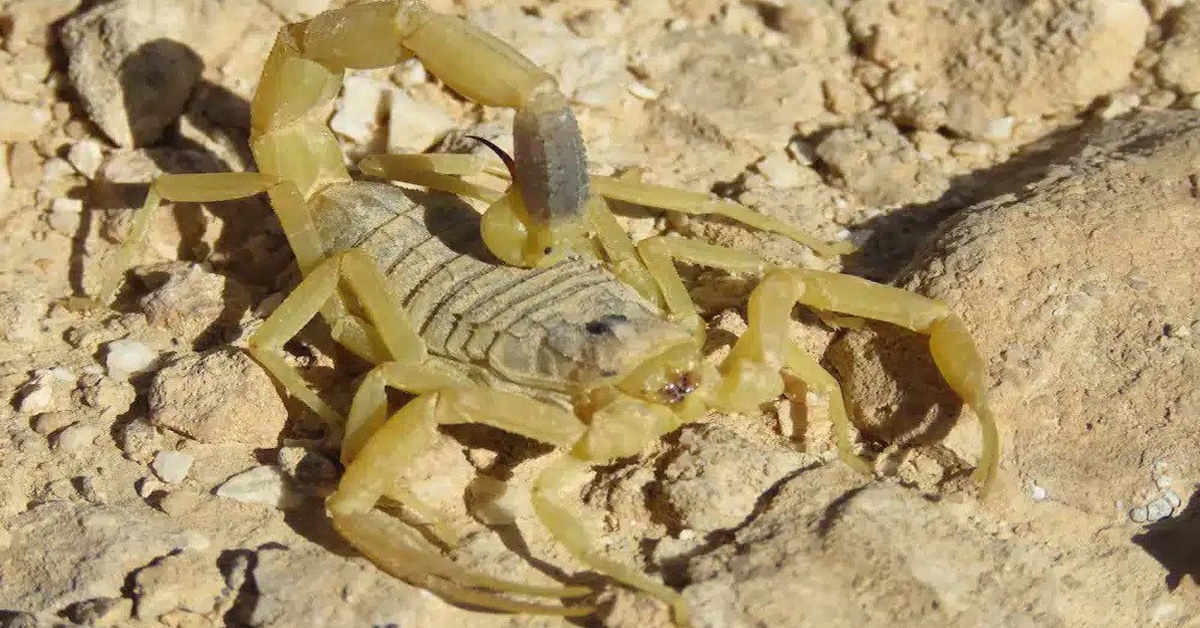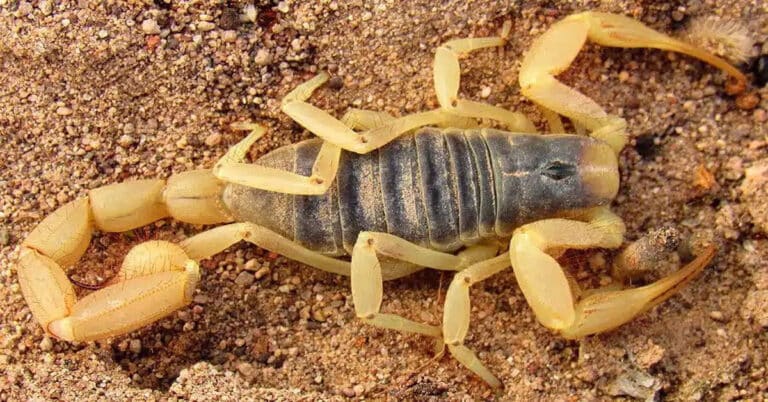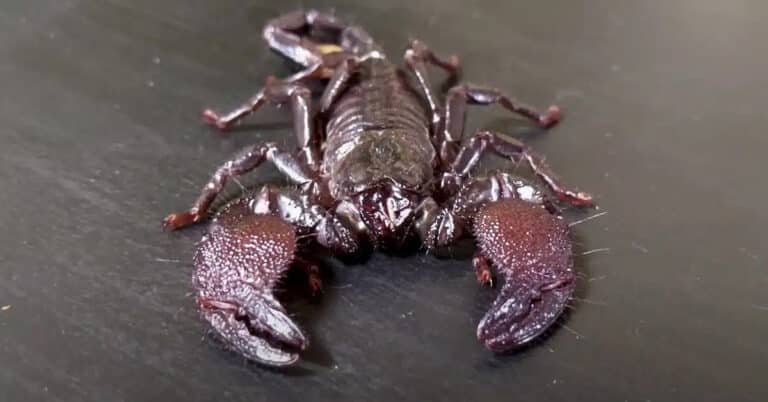Deathstalker Scorpion – Worlds Deadliest Animals Facts
Scorpions are one of the first animals to have ever evolved on this Earth, the first of their species coming around roughly 460 million years ago. Deathstalker scorpions have become one of the most popular species in the world.
But first, let’s get into the history of scorpions.
They’re also thought to be the first animal to ever venture out of the water onto land. Scorpions were able to do this because they do not have lungs like us, but host the ability to reserve oxygen in their cells for extended periods of time.
Considering the former, scorpions can live in radioactive climates with no ill effects, and they can also remain alive under water for up to two days.
People from Florida know this; they find scorpions walking along the bottom of their pools all the time.
Scorpions were quite sizeable when they first came around, the smallest of which reached over a meter in length, unlike the sub-seven inch species we see today.
Some fossils have even been found exceeding eight feet in length, which is truly frightening.
These are perhaps the most successful animals of all-time. They’ve been around nearly 500 million years, and they continue to thrive still to this day, ranging every continent on the globe aside from Antarctica.
Scorpions have evolved into nearly 2000 different sub-species today, from Emperor scorpions, Desert Hairy scorpions, a number of Bark scorpion and fat tail scorpion species, and many others, such as the one we’ll be talking about today, Deathstalker scorpions.
Before we get into this piece however, let’s go over the difference between venom and poison.
Many people writing similar articles, or people making videos for their animal YouTube channels will list these beings, along with others such as snakes and spiders, as poisonous, and that’s just simply inaccurate
Poison is either absorbed through the skin, or it is ingested.
This would make things such as some species of plants, frogs, and jellyfish, amongst others, poisonous. They do not have venom glands that inject you with toxins.
On the contrary, venom must be injected, making some species of snakes, as well as all species of scorpions and over 95% of spiders venomous.
Okay, now that you know the difference between poison and venom, let’s get into it!
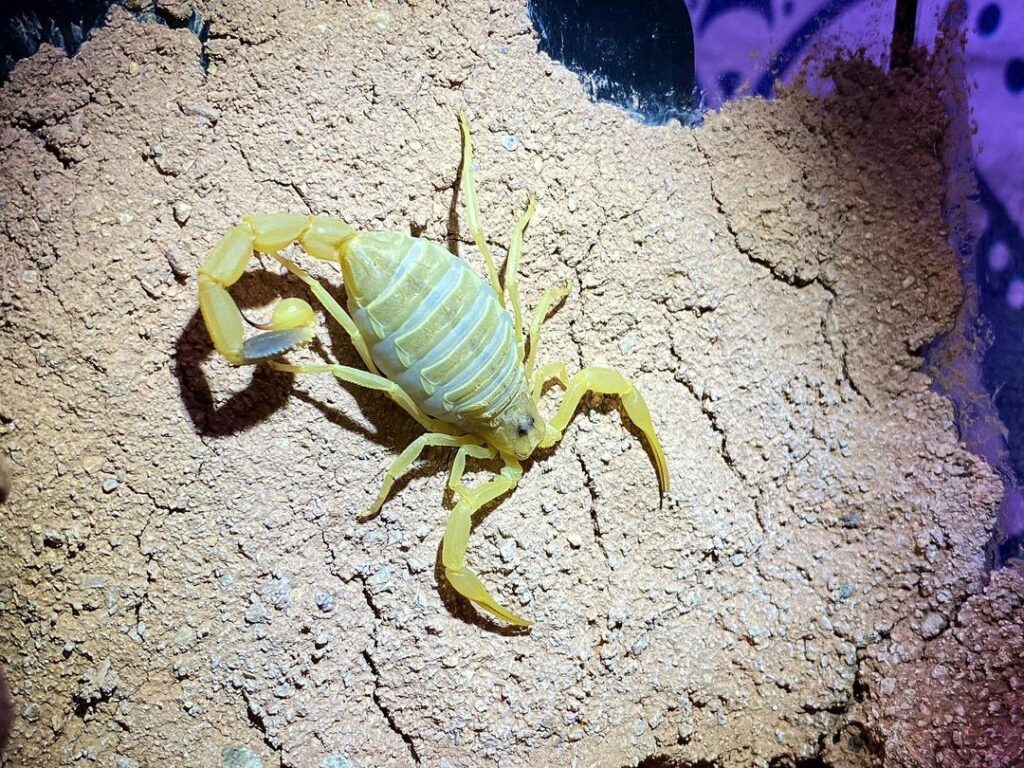
Deathstalker Scorpions
Deathstalker scorpions get a bad rep simply because of how dangerous they are, possessing the second-most toxic venom of all scorpion species still alive today.
They also inhabit many areas that human beings are native to, often times being found under furniture, in shoes, and even in ones bedding.
Deathstalker scorpions, along with others, enjoy the dark as they’re nocturnal creatures.
The sunlight will cook them, thus the reason they hunt at night, and dark crevasses make them feel secure and safe.
Size
This beautiful scorpion is one of the smaller species in existence, reaching between 1.2-and-3 inches long with an average of 2.3 inches.
All scorpions are quite fast, but as you probably could have guessed, the smaller, the faster.
That makes it even more dangerous for humans to be around these animals, because they will sting without warning, and chances are, you won’t be quick enough to react in time.
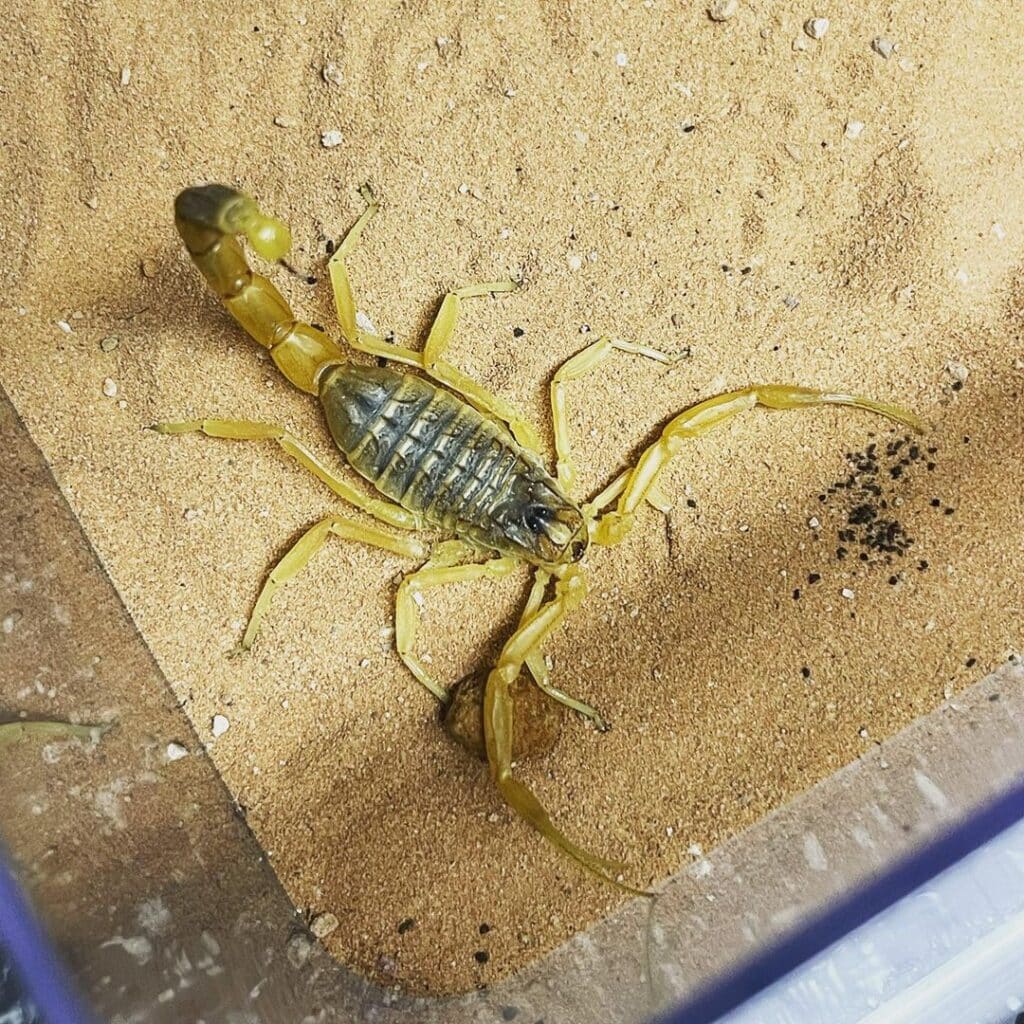
Range & Habitat
Deathstalker scorpions inhabit the North African and Middle Eastern deserts, ranging from Algeria in the west to Iran in the east.
In these areas, they’re generally found under rocks, wood, such as fallen trees and bark, as well as manmade structures (like homes as mentioned above) they can wedge themselves under.
Diet & Feeding
Deathstalker scorpions, like most other scorpions, feed on a variety of small insects, spiders, small centipedes, worms, other scorpions, and even small mammals.
Scorpions lie and wait for prey to walk into their striking range, sensing the vibrations around them with the microscopic hairs coating their legs and pedipalps (claws).
Once prey is close enough, they clamp down on it with their pedipalps before injecting it with a dose of their venom.
Then, once their prey is caught and envenomated, scorpions begin tearing it apart and ingesting it with chelicerae, which comes in two pairs of mouthpart appendages.
Often times, especially as youngsters, scorpions will feed on their siblings when they’re molting and defenseless. Mothers will also eat a few of her own young, young that grew inside of her for between 122-and-277 days.
That’s a 155 day span, which is quite remarkable.
That would be due to the fact that gravid females will wait until their environment is perfect to lay her live young. Once she’s done giving birth, she’ll have between 35-and-87 babies crawling on her back for the next two-to-four weeks.
Molting
Once they’ve molted for the first time, they’ll climb off their mothers back and venture out on their own. They have so many babies because, for one, as mentioned above, she will eat some of them.
But, also because not many of which will survive to adulthood.
There are so many things that can go wrong for a baby scorpion in the wild.
As babies, there are a number of animals out there bigger than them, even as adults, and they’re always vulnerable when molting. They may not even molt successfully, they may get stuck in it and die right there.
This is particularly common with desert species, as the climate is quite dry at all times, and moisture aids them in climbing out.
Even after their molt is complete, their exoskeleton is very soft for up to a week following, forcing them to hide without eating until their skin hardens.
Identifying Deathstalker Scorpions
Firstly, there’s the tiny size of this species; if they’re ridiculously small, and you see them in the areas mentioned above, you could be observing a Deathstalker scorpion.
Deathstalkers are yellow in color with a darker, brownish abdomen.
The most notable feature of the Deathstalker scorpion however is their tail.
Directly below their telson (stinger) is a black segment; their segments connecting their body to their tails are yellow, the final segment leading up to their telson is black, and their telson is yellow, the same color as them.
If you see these identifying marks, be sure to keep your distance or handle them with extreme caution, perhaps with tools (tongs, a cup etc). Because if you don’t, it may be the last animal you’ll ever get the chance to be up close and personal with.
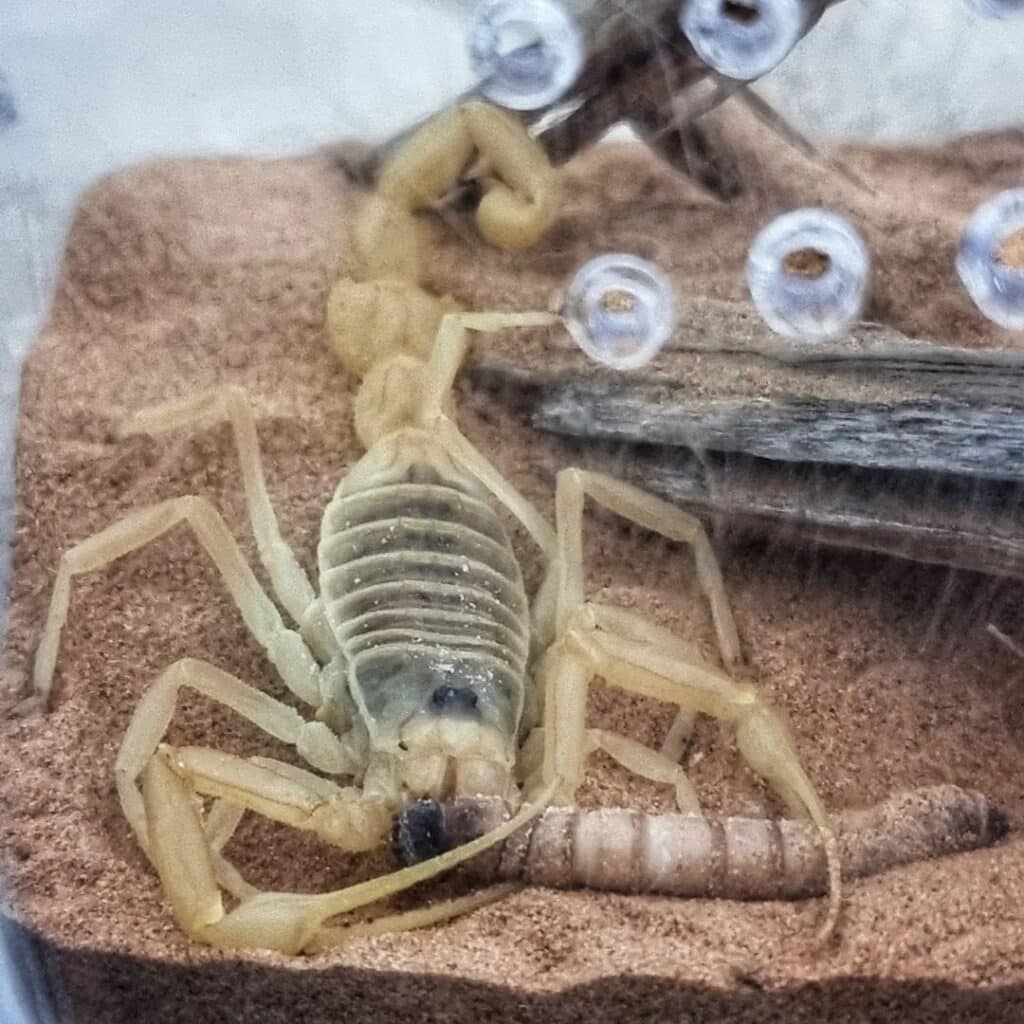
Venom
Deathstalker scorpions are widely known to be the second-most deadly scorpion in the world, thus the reason you must be wary around them.
Most healthy adults won’t die from a sting, though if you did, you wouldn’t be the first. However, their venom is most dangerous to children, older individuals, and individuals with heart conditions.
Deathstalker scorpions have an Ld50 of .25 kg, which is the same as a Saw-Scaled Viper.
Though the mortality rate of Saw-Scaled Vipers is around 20%, the snake still kills between 4,000-and-5,000 people every year in India.
Deathstalker scorpions have a neurotoxic and cardiotoxic venom that is extremely painful once injected, and more often than not, it leads to paralysis (inability to move and feel parts of the body).
This is followed by nausea and vomiting, abdominal cramps, and diarrhea. All of that has a good chance of leading to convulsions and fluid retention in the lungs, which certainly has the potential of leading to ones death.
Indian Red Scorpions
We mentioned how Deathstalker scorpions are the second-deadliest scorpion in the world; Indian Red Scorpions take the no. 1 spot on the chart with an Ld50 level of .21 kg.
Indian Red Scorpions are found in Eastern Pakistan, Eastern Nepal, Sri Lanka, and of course, throughout India.
They range from 2-to-3.5 inches in length, and fatality rates of this species are between 8-and-40%, most mortals being children under the age of 12.
Like Deathstalkers, Indian Red Scorpions possess a neurotoxic venom that blocks potassium channels in the body, which causes rhythmic fluctuations in blood pressure, leading to cardiovascular collapse.
Left untreated, the venom of this species can lead to pulmonary edema (leaking fluid into the lungs), resulting in the sting victims death within 72 hours.
If you enjoyed this piece, feel free to share it on social media!

I started writing in the fourth quarter of 2018. I wrote solely about MMA and boxing up until October of 2022, where I began writing about animals; primarily dangerous, venomous species. They’ve always fascinated me. Considering, my goal is to make a living by teaching people about these wonderful creatures. You can check out my Facebook page, where every article I’ve ever written currently sits, or you can check out my Twitter page, where I’ve shared all of my animal pieces to date.

